How to plant a ficus tree?

Ficuses are very popular with our flower growers - they are quite beautiful, at the same time, completely unpretentious flower in care, which even beginners can cope with growing. Transplanting this flower into a pot does not present any difficulties, but for a start it is important to decide whether you will propagate the ficus by layering, cuttings or leaves.
General principles of planting
The peculiarities of planting ficus in the ground largely depend on the method in which it is planned to propagate this plant.
- By shoots... In this case, a sprout with 2-3 leaves is separated from the mother flower, the lower one is immediately cut off, and the upper one is cut by about 1/3 and blotted with a napkin to remove all the juice that flows out. After that, the powder is placed in a container with water, a little activated carbon is added to avoid decay, and the process is left in this state for 30–40 days. The liquid from the vessel gradually evaporates, so it needs to be topped up from time to time. When the very first roots appear, you can carefully transplant the plant into a container with earth.
- Leaves... Ficus can be grown not only from a shoot, but even from a single flower. At the same time, it should be borne in mind that if you just cut off the leaves from an adult plant, then they can grow and develop, but you will not be able to grow a real full-fledged ficus - for this you need to cut off the leaf along with a small fragment of the stem and the cut must be beveled. Immediately after this, it is necessary to rinse the cut fragment under running water so that all the juice comes out and dry. The leaf is folded into a tube and fixed with a thread. After that, a wooden stick is passed through the holes in the folded sheet and, together with the tip of the stem, is stuck into the ground - the stalk formed in this way quickly takes root and takes root.
- Cuttings... In the spring and in the first half of summer, the ficus is propagated by cuttings, it is at this time that the plant goes into active growth, so root formation occurs rather quickly. For rooting, take the tops of shoots 10-15 cm long. You do not need to cut off too large areas with many leaves - such cuttings will actively evaporate liquid and the seedling, which has not yet formed its own root system, will simply wither. The branch is placed in water, and when well-developed roots appear on it, they are transplanted into the ground.
- Air layering. This is a very interesting breeding technique. An incision is made on the trunk of the ficus with a sharp knife so that its length is about 1/3 of the size of the stem. It is necessary to insert a wooden stick or a match without sulfur into it - otherwise it will grow quickly, after which it is necessary to overlay the cut with moss and wrap it with foil. From time to time, sphagnum needs to be moistened - it should always remain wet. After about a month, you can see the very first roots - then the cutting is cut and transplanted into the ground.
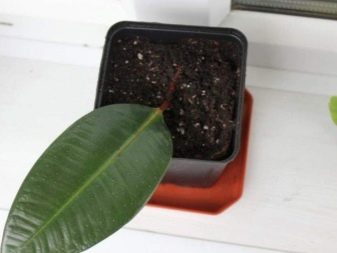

It should be noted that ficus transplantation is carried out in the following cases, which are not related to reproduction:
- like any other houseplant, ficus is transplanted after purchase;
- as the ficus grows, its roots may become cramped, in this case, a plant transplant into a new, more capacious pot is required;
- the substrate in the pot tends to deplete over time, therefore, about every two years, any indoor plants are transplanted into a new, more fertile and mineral-rich soil;
- in some cases, the transplantation of ficuses is required after an attack by pests or due to illness.
Preparation
At the stage of preparing the ficus for planting, it is very important to choose the right soil mixture and select the optimal capacity. In order for a young plant to take root well, and for an adult to take root as quickly as possible in new conditions, it is necessary to purchase suitable soil in stores. However, if you wish, you can prepare the ground yourself, for this you should follow these steps:
- you need to mix perlite, as well as vermiculite and peat in equal volumes and mix thoroughly:
- add pure river sand in proportion to the resulting mixture, as 1: 3;
- prepare expanded clay or pebbles for arranging the drainage system.
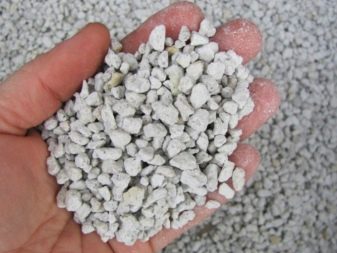

The soil should not be too greasy and heavy; ficuses love loose soil saturated with nitrogen.
If desired, you can introduce a little superphosphate and any organic fertilizers - this will fill the soil with all the nutrients necessary for the ficus.
Keep in mind that the roots of this plant develop rather quickly and grow in size, so when buying a suitable container, you should be guided by the following rules:
- the diameter of the container should be slightly larger than the size of the root system, by 2-3 cm;
- when growing ficus, you need to ensure that a small gap remains between the roots and the walls of the pot - about 2.5 cm, the roots should not rest against the walls of the container;
- it is advisable to choose a ceramic pot for the ficus, air will penetrate into the ground through its pores, as a result the roots will be stronger and stronger;
- medium-sized drainage holes must be made in the pot; if they are too narrow, then the water will begin to stagnate and swamp, and too large, on the contrary, cause the earthen coma to dry out.

Important! Ficus, especially if it is rubbery, grows rather quickly in height, so the container should be as heavy and as stable as possible, otherwise the risk of a flower falling is not excluded.
How to plant a ficus tree?
The optimal time for transplanting ficus is spring, in which case, before the onset of cold weather, the plant has time to adapt to the changing microclimate. In the autumn-winter period, the transplant is carried out only in case of plant disease, as well as in violation of the integrity of the pot, the occurrence of an unpleasant odor or the settlement of the land by crop pests. The procedure for transplanting step by step is as follows:
- when transplanting a ficus to the bottom of the pot, it is necessary to pour a drainage with a height of about 2 cm, then add a prepared soil mixture: for an adult plant, up to about half the volume of the pot, and for a young sprout, the container is filled almost entirely;
- after that, a small depression is formed, the ficus is carefully placed so that the roots do not bend, and pour out the rest of the substrate;
- after planting, the flower is watered abundantly, and after 15–20 minutes, the remaining moisture is drained from the pallet.
Mature plants are often transplanted into a new container using the transhipment method. To do this, the ficus in an old pot is watered a little, and then the walls are tapped - this is necessary so that the earthen lump quickly moves away from the walls of the container. Then the flower is turned upside down, continuing to tap on the walls and bottom, and the plant is carefully removed. The taken out tree is moved into a new pot, and the resulting voids between the lump of earth and the walls of the new container are filled with soil. Keep in mind that during transportation, the root collar should remain at the same level - it does not need to be buried and covered with earth, otherwise the ficus will begin to rot rather quickly.
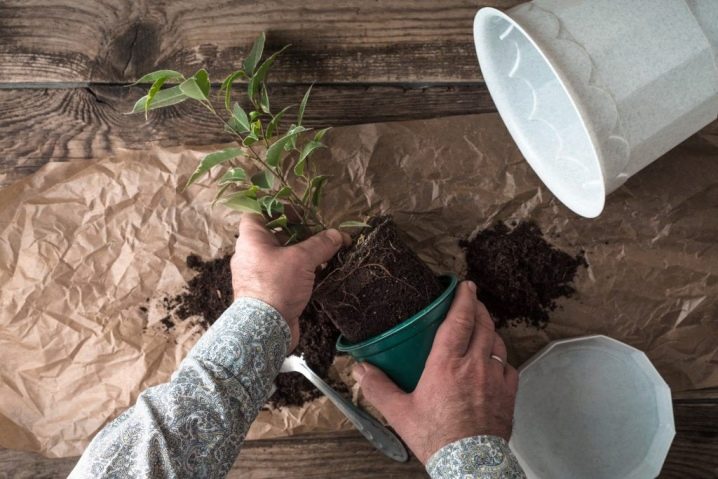
The transplanted flower is watered abundantly, and then all excess liquid is drained from the pan. Usually, after such a transplant, the ficus sheds up to 35-40% of its leaves. This should not bother you, since such a phenomenon is considered acceptable when adapting to your new living conditions. In some cases, the transshipment is accompanied by a complete replacement of the land - this is done if the tree is too large or the appearance of pests, as well as a disease of the plant, became the reason for replanting.
According to the rules of agricultural technology, in this case, the plant is watered very abundantly. While the ground is wet, carefully free the roots from adhering lumps of soil, then gently rinse in a deep bucket of warm water, cut off all diseased and decayed parts of the roots, treat with a light solution of an antiseptic or fungicide and transplant into a new container with a prepared earthen mixture. The first time after transplanting, the ficus adapts to new living conditions, therefore, it is necessary to provide it with the most comfortable conditions - the absence of direct ultraviolet light, draft, strong wind and temperature changes. For healthy adults, the transplant is not carried out - in this case, it will be quite enough to simply replace the top layer of the soil with a new nutrient.
To this end, the flower is watered with warm, settled water and a 5–6 cm layer of old soil is removed, after which the pot is filled with the same amount of new substrate.
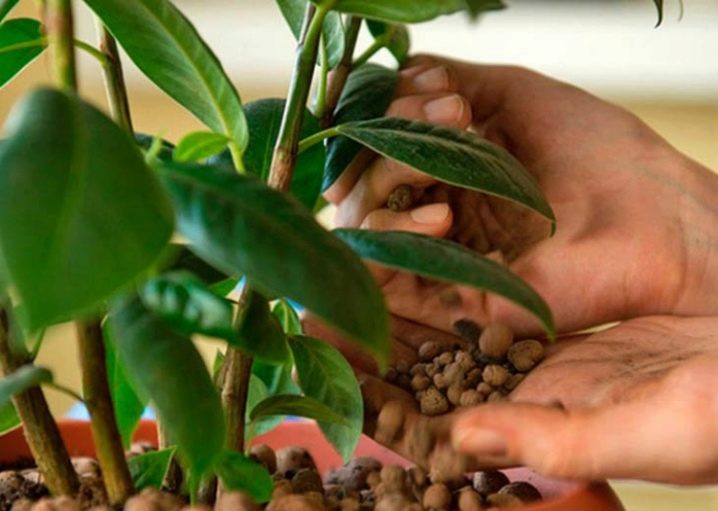
Many people underestimate the importance of transplanting ficus after purchase - this is a fairly common mistake. The fact is that store-bought soil mixtures contain special chemical additives that are used to preserve the attractive presentation of the plant. They are not suitable for long-term use, as a result, the plant weakens and dies if the soil is not promptly changed to a more nutritious and fertile one. That is why, after buying a ficus, he should be given several weeks to get used to the new microclimate, and then carefully transplanted with a complete replacement of the substrate. Only in this case your "green pet" will be able to retain its decorative effect and the ability to actively grow and reproduce.
Follow-up care
In order for the ficus to take root well and continue to develop actively after transplantation, you should follow the rules of caring for him.
- To begin with, it is necessary to ensure the optimal irrigation regime - the flower needs to be moistened regularly, about 2 times a week. The quality of the water used is of fundamental importance - experienced flower growers advise using settled or filtered water, always at room temperature. Tap water is quite hard, which leads to a deterioration in the quality of the substrate and, accordingly, disrupts the supply of the green parts of the plant with the necessary nutrients.
- Ficus prefers warmth. A comfortable room temperature for him is + 23– + 25 degrees throughout the year. Keep in mind that the plant does not tolerate direct sunlight, reacts negatively to drafts and dry air.
- Particular attention should be paid to chemical stimulation of the ficus. The plant requires the introduction of periodic dressings and mineral dressings. During the period of active development from February to October, feeding is carried out every 2 weeks, and during the rest period from November to January, it is limited to making feeding once every 30–40 days. As a fertilizer, it is best to use ready-made complex formulations created specifically for ficuses - you can find them in any store for gardeners and gardeners.
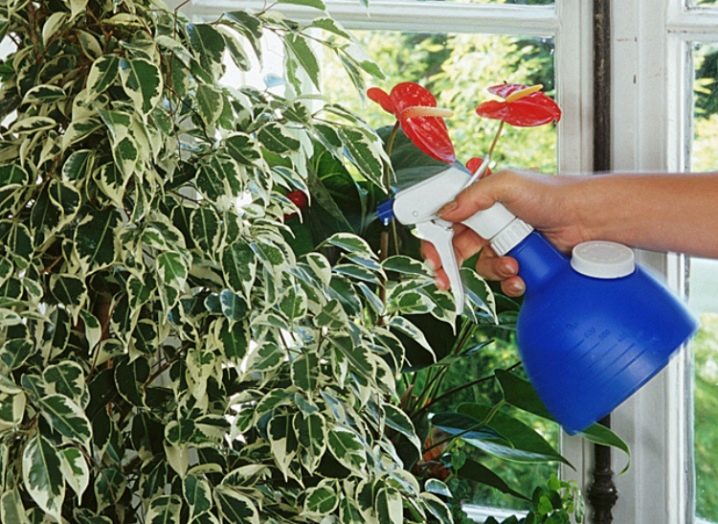
Ficuses are rather unpretentious flowers that harmoniously fit into any home interiors. Caring for them does not present any trouble for a florist, and even an inexperienced owner can cope with transplanting.By following the instructions above, you can plant a young ficus tree yourself or renew the soil mixture of an adult flower so that it will delight you with its bright greenery and exotic appearance for a long time.
The reproduction of ficus is described in the following video.































The comment was sent successfully.